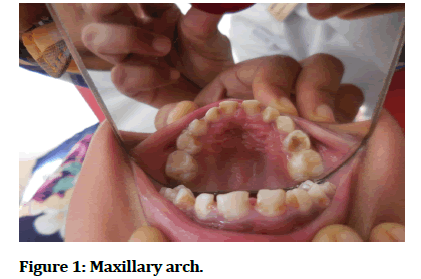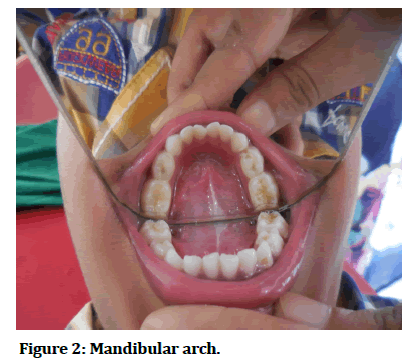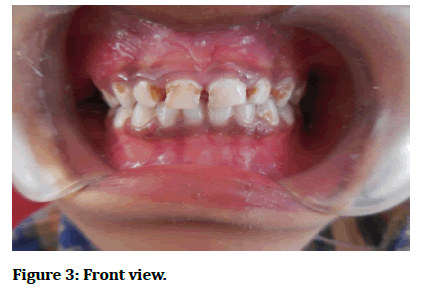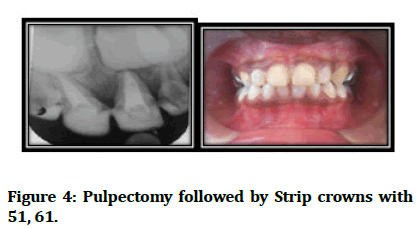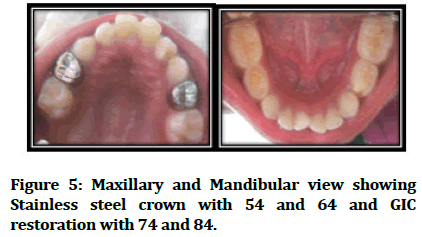Case Report - (2022) Volume 10, Issue 1
Dental Rehabilitation in Early Childhood Caries: A Case Report
Milind Wasnik1*, Arun Sajjanar2, Suryakant Kumar3, Niharika Gahlod1, Sneha Khekade2, Pratima Kolekar4 and Dishika Bhagwani4
*Correspondence: Milind Wasnik, Senior Lecturer, Department of Pedodontics and Preventive Dentistry, Swargiya Dadasaheb Kalmegh Smruti Dental College and Hospital, Wanadongri, Nagpur, Maharashtra, India, Email:
Abstract
Early childhood caries (ECC) is a potent form of dental caries which destroy mostly the primary dentition of toddlers as well as preschool children. It is usually prevalent in low socioeconomic groups and also in general population. Early childhood caries also has more widespread health issues besides affecting the teeth. This paper presents a case report of a 5-year-old male patient, diagnosed with ECC and describes the therapeutic approach, rehabilitative and restorative treatment of child. Treatment plan included oral prophylaxis followed by GIC restoration, Pulpectomy, Strip crowns and Stainless Steel Crowns. The treatment provided a positive psycho-social impact on the patients, not only by oral health recovering but also by the reestablishment of a better quality of life. This paper explains that it is important that the dentists should be capable of early diagnosing and management of early childhood caries.
Keywords
Early childhood caries, Pediatric dentistry, Dental caries.
Introduction
Early childhood caries (ECC) is a potent form of dental caries which destroy mostly the primary dentition of toddlers as well as preschool children. It is usually prevalent in low socioeconomic groups and also in general population. Early childhood caries also has more widespread health issues besides affecting the teeth [1]. Health professionals have an important role in diagnosing of early childhood caries. They can promote the oral health of infants and children by learning about oral development, oral disease, oral hygiene, fluoride, and nutrition and by sharing information with parents. They can also help to make certain that infants and also the young children receive the care they need by referring infants to a dentist for an oral examination in case of any caries [2,3].
Early childhood caries by nature is rampant, acute, and progressive. If the progression of the caries condition is not interrupted, serious local, systemic, aesthetic, psychological and social problems could be resulted [4]. Severe early childhood caries (S-ECC) is common and it mostly damages the speech, swallowing, feeding, and ultimately the overall growth and development, esthetics and emotional (self-esteem) of the child. Deleterious habits and also the unrestricted use of baby bottle, mainly with sugar content during night, are associated with severe early childhood caries [5].
The initial clinical sign of early childhood caries includes presence of opaque and white spots over tooth. If not treated it leads to appearance of cavities, and this can lead to the destruction of complete crown portion of tooth and initiate infectious root processes because of pulp involvement. ECC begins mostly on the cervical third of the labial surfaces of the maxillary anterior teeth and concurrently affects the occlusal surface of the maxillary and mandibular first molars, maxillary and mandibular canines and second molars. At more advanced stages, it affects also the mandibular incisors [6,7].
Case Report
A 5 years old male patient visited to the department with chief complaint of pain in upper right and left back region of jaw since 1 month. Patient also complained of decayed tooth. The pain was dull aching and intermittent in nature. Pain aggravated on mastication and relieved on rest. There was no relevant history of any major illness, allergies, hospitalization and blood transfusion reported by parents. Deep occlusal caries was present with 64. (Figure1). Occlusal caries was present with 74 and 84 (Figure 2) Proximal caries was present with 51, 52,54,61,62 and Smooth surface caries was present with 53 63 and 73. (Figure 3) The diagnosis of Early Childhood Caries was made. On radiographic examination, it was observed that the radiolucency was seen on the proximal aspect of 51, 61, 54 and 64 involving enamel, dentin and pulp. Treatment plan included oral prophylaxis followed by GIC restoration with 52, 53, 62, 63, and 73 (Figure 4). Pulpectomy followed by Strip crowns with 51, 61 was planned. (Figure 4). Pulpectomy was planned with 64 and 54 followed by SSC (Figure 5).
Figure 1: Maxillary arch.
Figure 2:Mandibular arch.
Figure 3:Front view.
Figure 4:Pulpectomy followed by Strip crowns with 51, 61.
Figure 5:Maxillary and Mandibular view showing Stainless steel crown with 54 and 64 and GIC restoration with 74 and 84.
Discussion
Early childhood caries can be defined as the presence of one or more carious lesions present on teeth which are either cavitated or not, in children up to five years of age. The etiology of early childhood caries is very complex and involves interactions between behavioural, social and microbiological factors. The other factors such as low parental education and low socioeconomic status contribute to the higher prevalence of Early Childhood Caries [8,9]. Multiple risk factors are involved leading to caries and further pain, premature tooth loss, and also the malnutrition, growth retardation, speech problems, difficulty in chewing, overall health disorders and also has a psychological impact on child [10,11]
Early Childhood Caries is transmissible and infectious disease. Early Childhood Caries is characterized by widespread, rapidly progressive and deep decay of the upper primary incisors and often the primary molars. These decayed teeth may become necrotic and often causes abscess leading to a cellulitis of the surrounding soft tissues [12]. Early Childhood Caries if left untreated may lead to serious illness, infection, and pain, which in turn can impair weight gain and speech while leading to learning and eating problems [13].
Prevention of Early Childhood Caries begins with intervention in the prenatal and perinatal periods. The specific cariogenic bacteria i.e Streptococcus mutans may be transmitted to the child from the mother. Hence decreasing the mother's Streptococcus mutans levels may decrease the child's risk of developing. Motivational interviewing may also help direct parents to improve home oral health habits. Frequent bottle feeding at night and at will breastfeeding may increase the prevalence of early childhood caries. It may not arise from breast milk alone, breastfeeding in combination with other carbohydrates has been found to be highly cariogenic. The severity of early childhood caries is mainly associated with poor feeding habits [13].
The oral rehabilitation of the present case was planned based on the patient's age, clinical findings and patient’s cooperation. In this case, it was decided to start treatment with the selective caries removal due to the degree of coronal destruction. Deep occlusal caries was present with 64 and proximal caries was present with 54. Pulpectomy was planned with 64 and 54 followed by Stainless Steel Crown. Deep Proximal caries with 51 and 61. Pulpectomy followed by Strip crowns was planned with 51, 61.Smooth surface caries was present with 52, 53,62,63,73. GIC restoration was planned with 52, 53,62,63,73. The strip crowns filled with resin composite were chosen for the oral rehabilitation in this case report as it has been a good option in cases where tooth crowns are much destructed.
Conclusion
Prevention of early childhood caries should be very important. Proper knowledge should be provided to mothers, caregivers, community health workers, preschool teachers and children. It is important that the dentists should be capable of early diagnosing and management of early childhood caries. The treatment should provide a positive psycho-social impact on these patients, not only by oral health recovering but also by the reestablishment of a better quality of life.
References
- Mishra A, Pandey R, Pandey N, et al. A pedoprosthetic rehabilitation in patients with severe early childhood caries (S-ECC). Case Reports 2013; 2013.
- American Academy of Pediatric Dentistry. American Academy of Pediatric Dentistry reference manual. Am Acad Pediatr Dent 2008.
- Seow WK. Biological mechanisms of early childhood caries. Community Dent Oral Epidemiol 1998; 26:8-27.
- American Academy of Pediatrics. Policy on early childhood caries (ECC): Classifications, consequences, and preventive strategies. Pedia Dent 2008; 30:40-3.
- Tiberia MJ, Milnes AR, Feigal RJ, et al. Risk factors for early childhood caries in Canadian preschool children seeking care. Pedia Dent 2007; 29:201-8.
- Losso EM, Tavares MC, da Silva JY, et al. Cárie precoce e severa na infância: Uma abordagem integral. J Pediatria 2009; 85:295-300.
- Milgrom P, Chi DL. Prevention-centered caries management strategies during critical periods in early childhood. J Calif Dent Assoc 2011; 39:735-41.
- Congiu G, Campus G, Lugliè PF. Early childhood caries (ECC) prevalence and background factors: a review. Oral Health Prev Dent 2014; 12:71-6.
- dos Santos Junior VE, de Sousa RM, et al. Early childhood caries and its relationship with perinatal, socioeconomic and nutritional risks: a cross-sectional study. BMC Oral Health 2014; 14:1-5.
- Kagihara LE, Niederhauser VP, Stark M. Assessment, management, and prevention of early childhood caries. J Am Acad Nurse Pract 2009; 21:01- 10.
- Folayan MO, Kolawole KA, Oziegbe EO, et al. Prevalence, and early childhood caries risk indicators in preschool children in suburban Nigeria. BMC Oral Health 2015; 15:1-2.
- Acs G, Shulman R, Chussid S, et al. The effect of dental rehabilitation on the body weight of children with early childhood caries. Pediat Dent 1999; 21:109-13.
- Berkowitz RJ. Causes, treatment and prevention of early childhood caries: a microbiologic perspective. J Can Dent Assoc 2003; 69:304-7.
Indexed at, Google Scholar, Cross Ref
Indexed at, Google Scholar, Cross Ref
Indexed at, Google Scholar, Cross Ref
Indexed at, Google Scholar, Cross Ref
Indexed at, Google Scholar, Cross Ref
Indexed at, Google Scholar, Cross Ref
Author Info
Milind Wasnik1*, Arun Sajjanar2, Suryakant Kumar3, Niharika Gahlod1, Sneha Khekade2, Pratima Kolekar4 and Dishika Bhagwani4
1Senior Lecturer, Department of Pedodontics and Preventive Dentistry, Swargiya Dadasaheb Kalmegh Smruti Dental College and Hospital, Wanadongri, Nagpur, Maharashtra, India2Professor and HOD, Department of Pedodontics and Preventive Dentistry, Swargiya Dadasaheb Kalmegh Smruti Dental College and Hospital, Wanadongri, Nagpur, Maharashtra, India
3Reader, Department of Pedodontics and Preventive Dentistry, Swargiya Dadasaheb Kalmegh Smruti Dental College and Hospital, Wanadongri, Nagpur, Maharashtra, India
4PG Student, Department of Pedodontics and Preventive Dentistry, Swargiya Dadasaheb Kalmegh Smruti Dental College and Hospital, Wanadongri, Nagpur, Maharashtra, India
Citation: Milind Wasnik, Arun Sajjanar, Suryakant Kumar, Sneha Khekade, Miranda George, Durga Bhattad, Dental Rehabilitation in Early Childhood Caries: A Case Report, J Res Med Dent Sci, 2022, 10(1): 355-357
Received: 06-Dec-2021, Manuscript No. Jrmds-21-41038; , Pre QC No. Jrmds-21-41038 (PQ); Editor assigned: 08-Dec-2021, Pre QC No. Jrmds-21-41038 (PQ); Reviewed: 22-Dec-2021, QC No. Jrmds-21-41038; Revised: 27-Dec-2021, Manuscript No. Jrmds-21-41038 (R); Published: 03-Jan-2022

